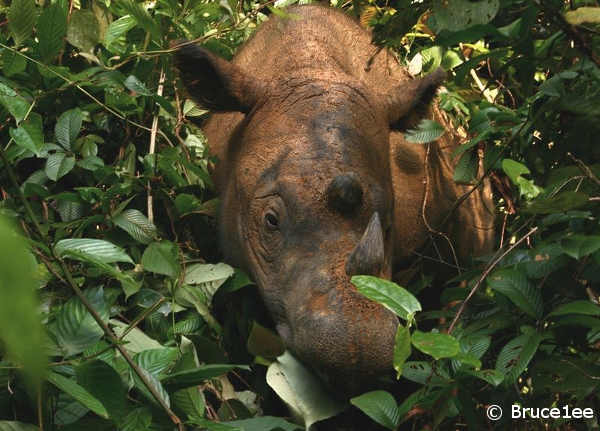
The Sumatran rhino, EDGE mammal number 10 is the most endangered of all rhinoceros species because of its rapid rate of decline. This extraordinary species once roamed throughout South-east Asia. Now after years of hunting, poaching and habitat destruction, the last remaining individuals occupy isolated parts of Indonesia and Malaysia. Recent data from governments, NGOs and researchers indicate that the global population could be as low as 216 and in immediate need of action.
In a recent review in Oryx: Now or never: what will it take to save the Sumatran rhinoceros Dicerorhinus sumatrensis from extinction? The authors look at what has been done in the last 16 years after gaps in conservation efforts were identified by Alan Rabinowitz. Despite revealing a troublesome situation, the review also presents a strong case for what should be our current priorities and actions to prevent the species extinction: semi-in situ captive breeding programmes and securing priority areas with improved law enforcement coverage and monitoring capacities.
Due to habitat loss and poaching Sumatran Rhinos are now probably confined to protected lowland or high-altitude forests, areas difficult to convert. This ironically, has turned a new factor into the major driver for the species decline: a small population. For a species to avoid extinction it must sustain a minimum population size so that birth and death rates are balanced. Small populations bring several factors which can drive decline, such as difficulty for individuals to find a fertile mate. Poaching for traditional Chinese medicine, which used to be the primary risk, is now the second largest threat to the Sumatran Rhino.
According to the report the situation in Peninsular Malaysia is the grimmest. Despite having the largest amount of what appears to be suitable available habitat the remaining population is either negligible or already wiped out. During the 90s there were several reports of poaching and in recent years surveys show no signs of individuals. Thus, even if there are a few individuals left, it is unlikely that they would be able to reproduce and sustain a population.
In Sumatra, despite eight populations disappearing in the last 15 years, two sites still hold populations of D. sumatrensis with reasonable encounter rates: Bukit Barisan Selatan and Way Kambas National Parks. In Way Kambas there is a stabilised semi-in situ Sumatran Rhino Sanctuary. This is a semi-wild breeding program that, despite being far from perfect, may be instrumental in preventing the species extinction. Traditional captive breeding efforts have largely failed for this species, and thus this semi-wild captive management might be the only way of increasing the species numbers. In Way Kambas, rhinos have forest habitats and natural conditions to improve chances of breeding, and carefully managed captive breeding centres in native habitats. Semi-in situ captive breeding is considered to have the largest possibility of success not only because of its natural settings but also because of the use of monitoring techniques (introduced by work in the Cincinnati zoo) to determine the best time for introducing males and females.
In Sabah, Danum Valley Conservation Area and Tabin Wildlife Reserve support the State’s largest D. sumatrensis populations, rivalling those in protected areas of Sumatra for encounter rates. Based on The Way Kambas semi-wild breeding model the Sabah government launched a rescue programme for D. sumatrensis in 2009 that endorses the establishment of a semi-in situ captive breeding facility within Tabin.
The authors propose the translocation of wild individuals from existing small, isolated or threatened forest patches into semi-in situ captive breeding programmes such as the two mentioned above to be also put in place for the other two viable populations (one in Sumatra and one in Sabah).With semi-captive breeding in these sites targeting the problems of small isolated population the second need is for an enhancement of protection and monitoring capacities in priority areas that have established these breeding facilities or have recorded relatively high population estimates in order to reduce the effects of poaching. If left alone it is clear the Sumatran Rhino could go extinct. However this does not need be the case. With more political support, better enforcement of wildlife laws, improved cooperation among stakeholders, and funds available to implement the strategy conservation can be successful.
“An opportunity exists for governments and society to guide conservation programmes to put the brakes on species extinctions,” said Julia Marton-Lefèvre, IUCN’s Director General with regard to the Arabian Oryx success story last week. This species of antelope after having been extinct in the wild now stands at a wild population of 1,000 individuals as a result of intensive captive breeding and reintroduction efforts.
The price of saving the Sumatran Rhino according to the proposed strategy is just over US $1.2 million per year. That is how much ‘Chevaliers en parade’ a painting by Salvador Dali, which depicts a knight, sold for in a recent auction. One can only hope that the Sumatran rhino will finds knights willing to bid for its life.
